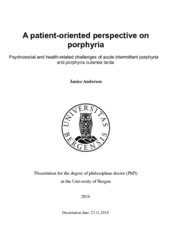A patient-oriented perspective on porphyria. Psychosocial and health-related challenges of acute intermittent porphyria and porphyria cutanea tarda
Doctoral thesis
Permanent lenke
https://hdl.handle.net/1956/13146Utgivelsesdato
2016-11-23Metadata
Vis full innførselSamlinger
Sammendrag
Background: To optimize patient care, follow-up and genetic counselling of persons with acute intermittent porphyria (AIP) and porphyria cutanea tarda (PCT), investigations into the subjective experiences of persons living with these conditions are warranted. Aims: The overall objective of this thesis was to investigate the psychosocial and health-related challenges faced by people with AIP and PCT. The specific aims were: 1) to investigate the subjective experiences of adolescents and young adults who were genetically tested for AIP as minors and to identify the psychosocial consequences and how they are handled; 2) to explore the experiences of persons with PCT concerning their symptoms, treatment, prevention and follow-up; 3) to describe and compare illness perception, self-reported health complaints and psychological distress in persons with various activity of PCT and 4) to examine the associations between illness perception, self-reported health complaints, PCT symptoms and psychological distress. Material and methods: In this thesis we used a multi-methods approach. Individual interviews were performed with 10 persons who had received a positive predictive genetic test result for AIP as minors. Three focus groups with a total of 21 persons with experience of the symptoms of PCT were carried out. The last part of the study was cross-sectional and included a questionnaire completed by 263 subjects who had PCT with active symptoms, were in a remission phase, or were an asymptomatic mutation carrier. Results: Young persons tested genetically for AIP described few psychosocial challenges but found it difficult to become motivated to make lifestyle modifications. For some, the thought of developing an active disease was a cause for concern. AIP was experienced as a vague condition, and participants and their families attributed a range of health complaints to porphyria. PCT was perceived as a chronic and systemic condition, and participants described a shift in their focus from skin to blood. Health complaints other than skin symptoms were attributed to PCT. Symptoms varied greatly and, at their worst, were dramatic and described as “living in a horror movie”. Participants with active PCT reported higher perceived illness threat, more subjective health complaints and higher degrees of psychological distress compared to asymptomatic participants. Psychological distress about PCT was however associated with perceptions of illness and total health complaints but not with PCT symptom activity. Conclusions and implications: The results from this study show that symptoms of PCT can be dramatic and should be addressed, but asymptomatic phases can also be problematic. Separating the symptoms of AIP and PCT can be difficult for patients, and a clearer definition of an AIP attack and PCT symptoms would be beneficial. When in a phase of active disease, it is important that patients know how to implement and increase their treatment compliance while also avoiding medicalization of persons in remission or at risk of developing AIP or PCT. Patients’ perceptions of the condition should be considered, and appropriate follow-up, counselling and reassurance during clinical consultations are recommended.
Består av
Paper I: Andersen J., Sandberg S., Råheim M., Gjengedal E.; Psychosocial aspects of predictive genetic testing for acute intermittent porphyria in Norwegian minors. Journal of Inherited Metabolic Disease Reports 2011; 1:1–7. Full text not available in BORA due to publisher restrictions. The article is available at: http://dx.doi.org/10.1007/8904_2011_8Paper II: Andersen J., Gjengedal E., Sandberg S., Råheim M.; A skin disease, a blood disease, or something in between? An exploratory focus group study of porphyria cutanea tarda. British Journal of Dermatology 2015; 172: 223–229. The article is available at: http://hdl.handle.net/1956/9015
Paper III: Andersen J., Nordin K., Sandberg S.; Illness perception and psychological distress in persons with porphyria cutanea tarda. Acta Dermato- Venereologica 2016; 96:674-678. The article is available at: http://hdl.handle.net/1956/13145
